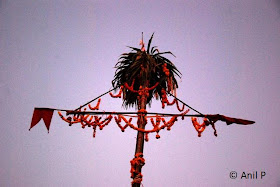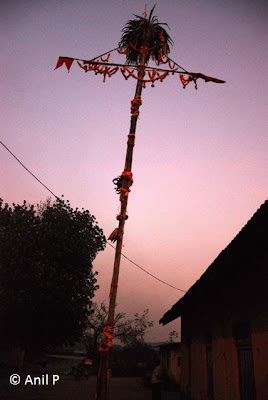
“You should’ve been here at 1:00 O’Clock,” a middle-aged, local man said, probably indicating the time of installation, as I stopped in the temple courtyard to photograph a high ceremonial mast likely constructed from Areca Nut trunk and bamboo and decorated with marigolds, and bananas among other nature offerings, the top surmounted by leaves, similar to the Gudi hoisted on Gudi Padwa.

It rose from a notch in the centre of a raised, square platform where people had made offerings of coconuts to the deity.

Jags and I were returning from a walk along the mudflats and mangroves in Karanjal when I first noticed the high mast erected in the temple courtyard. It was two days after Holi early this month and Shigmotsav celebrations had kicked off across Goa, particularly in the North of the state where traditionally Shigmo (Konkani for the month of Phalguna, the last month in the Hindu calendar) is celebrated from the day of the full moon of Phalgun month to the end of the month that culminates in Gudi Padva, the first day of the Hindu calendar year, that is today.
Only the day before, following Holi celebrations commencing on full moon in the month of Phalgun and lasting a day, I had seen the same sight in the vicinity of a temple in Bhoma as I rode a bus to Panjim. The bus had paused by the temple that sits off the highway, waiting for throngs of people who’d gathered for the installation of a similar ceremonial mast, to make way for the bus. One by one local villagers had come up to the platform from which the mast rose and broke a coconut on the platform as a ritual offering to the deity.
Elsewhere, depending upon the tradition followed at the temples, villagers erect Mango tree trunks or Areca Nut tree trunks though not necessarily restricted to the two. And in the days to follow, given that Shigmo is essentially a festival of music and dance observed largely by Goa’s farming community celebrating the arrival of Spring, villages, and particularly the temples, are transformed by the holding of folk dramas and dances like Khell, Romat, Jagor, Ranmalyem, Talgadi, and Ghodmodni among others.
Villages are not bound by a particular date on which to install the ceremonial mast, each dictated by tradition observed at the temple. Even the commencement of Shigmo celebrations varies across Goa, with South Goa observing it on the beginning of the month of Phalgun and concluding it on Phalgun Punav (Full moon of Phalgun month), while North Goa observes its commencement on Phalgun Punav and concludes it on Padva, today. However, exceptions can be found within each of the two regions. The difference in its observance had to do with the Portuguese banning its observance leading to the colony’s ingenious subjects cleverly disguising its observance along with the Carnival to escape censure and retribution.
“We will keep it until Padwa,” the middle-aged man said when I asked him how long will the ceremonial ‘trunk’ be retained. Today is Gudi Padva, and I believe, with much fondness and piety the ceremonial ‘mast’ will have been lowered. However, the actual Shigmo celebrations involving folk dramas and dances would normally extend only five days from the date of commencement of the Shigmo festival.

The middle-aged man was supervising a few local youth busy putting up a makeshift stage in the corner of the temple courtyard. “Dramas will be staged from tomorrow night,” he said. It’s a scene that repeats across Goa in temples where these celebrations take place. Not all Goan temples celebrate similarly.
“No. Around here you’ll get to see this in Durbhat,” a youth said when I asked him if every temple hosts these celebrations as in dances and dramas and the ceremonial ‘mast’ that he referred to as Shigmyache Holi, a term I felt might not be the original reference. He mentioned two other temples in the vicinity that I cannot remember clearly now.
A sodium vapour lamp cast a gentle glow on the activity below as the men discussed ways to reinforce and shape the makeshift stage where local artistes would stage their plays to villagers crammed in the courtyard. Curious of the atmosphere I made a mental note to ride over to the temple the next day and watch the plays with the villagers. I could not make it to the venue the next day.
However, the rhythmic beating of the drums, that familiar Ghanch-katar-ghanch, ghanch-katar-ghanch had floated on the Spring breeze in the days leading upto Shigmo and in the days since, quivering along quiet roads, stepping across lush green paddy fields, skipping over village ponds, all the while strengthening and waning depending on the breeze carrying the hypnotic beats towards or away as bands of drummers carried their drums from Vaddo to Vaddo, beating the familiar, throbbing beat pulsating with the energy and the promise of Spring, and of life itself.

A day earlier, on our way back through Chorao as we headed for the ferry crossing to Panaji, Philip and I had rounded a turn in the narrow road just before it ran through an open field and happened upon an enthusiastic band of drummers on the roadside hard at their drums.
A few shops and homes with sloping roofs lay on either side of the road, and local men stopped by to talk and offer encouragement. The Sun was descending behind the trees and the evening pulsated to a familiar rhythm from my childhood.

“Will you be participating in the Shigmo parade in Panaji?” I asked one of the drummers as he handed the sticks to a young child before turning to me to answer.
“No, no,” he said, smiling. “For the duration of the Shigmo celebrations, we’ll be moving from waddo to waddo, drumming our way through them.”
In the countryside, Goa resonates to the beat of Spring in Phalgun. Like the season itself, the drums regenerate the landscape, and memories.
And standing on the roadside I imagined children stepping out, as I once did, and dancing to the beats of an ancient people of an ancient land following an age-old tradition.

That was an informative post; thank you!
ReplyDeleteThe pictures look somewhat dark in my blackberry; will check out from home later.
Anil! Would you be interested in an interview post where I introduce you to my blog friends?
Let me know by email: nrigirl at hotmail dot com
Thank you!
Having recently read Connected Places: Region, Pilgrimage, and Geographical Imagination in India, by Anne Feldhaus, I am delighted to see your wonderful photos showing some of what was described in that book, Anil. Thanks so much! I especially liked the photo of the child with the drums and that you related your memories from your childhood.
ReplyDeletehttp://www.goodreads.com/book/show/271577.Connected_Places
This a fascinating account of the ceremonies and rituals there, Anil. I enjoyed your pictures and the telling of your story. The ceremonial mast is especially interesting. :-)
ReplyDeleteI had never heard of this before - thank you. :)
ReplyDeleteThank you for the guide through this beautiful area and it's wonderful that you have those memories.
ReplyDeleteAnil,
ReplyDeleteHow much I miss that!Thanks for transforming me back.
A part of tradition is also to do with remembering the ancestors. A lot of rituals take place in the cemeteries where they were cremated. You may know that in 'Sal' the remote part of Bicholim, people apparently are 'hidden' by the spirits of ancestors. A huge fire torch is said to be 'seen' on this night when the local deity in-charge of the village security is believed to be carrying it.
I'm glad that the tradition of processions are still kept alive albeit through the competitive spirits.
I'm hoping to see these celebrations whenever I get back sometimes.
I definitely would like to have some of these recordings on likes of Utube.
BTW in colloquial slang, 'Shigmo' is also referred to any kind of clamour. So the recently concluded elections for political supremacy was a 'Shigmo'.
-Magan
When was your last visiting Goa for Shigmo? And do all temples hoist/tie the mast or are there certain temples that do this? Is it a state holiday or is it not viewed as big a festivity as some others.
ReplyDeleteNRIGirl: Thank you. The pictures were taken in fading light.
ReplyDeleteWill mail, thanks.
Am: That must've been quite a coincidence. If I get hold of her book, I'll read it.
Daisy:Thank you.
Riot Kitty: It's not known much outside of Goa.
Lynn: Childhood is a repository of many such memories.
Magan: Yes, that's true, the bit of remembering ancestors. So much and so many are thanked in many of these rituals, making meaning of things one might otherwise ignore or take for granted.
True, over there people actually leave their homes to go stay in the jungles or woods as may be, living there for the duration.
Some of these might be available on YouTube though I haven't checked.
I'm sure there'd be many memories flooding back.
I remember the sarcastic colloquial Shigmya aila re :-)
Red: As early as early this month.
The answers are already in the post :-)
As for it being a holiday, Holi is, so the start is a holiday where it's celebrated in the second half of Phalguna, the continuation is not a holiday though.
Written like a true storyteller. I love your novel-like first-hand account of the ceremony. Nice photos as well.
ReplyDeleteMy fav festival :D
ReplyDelete